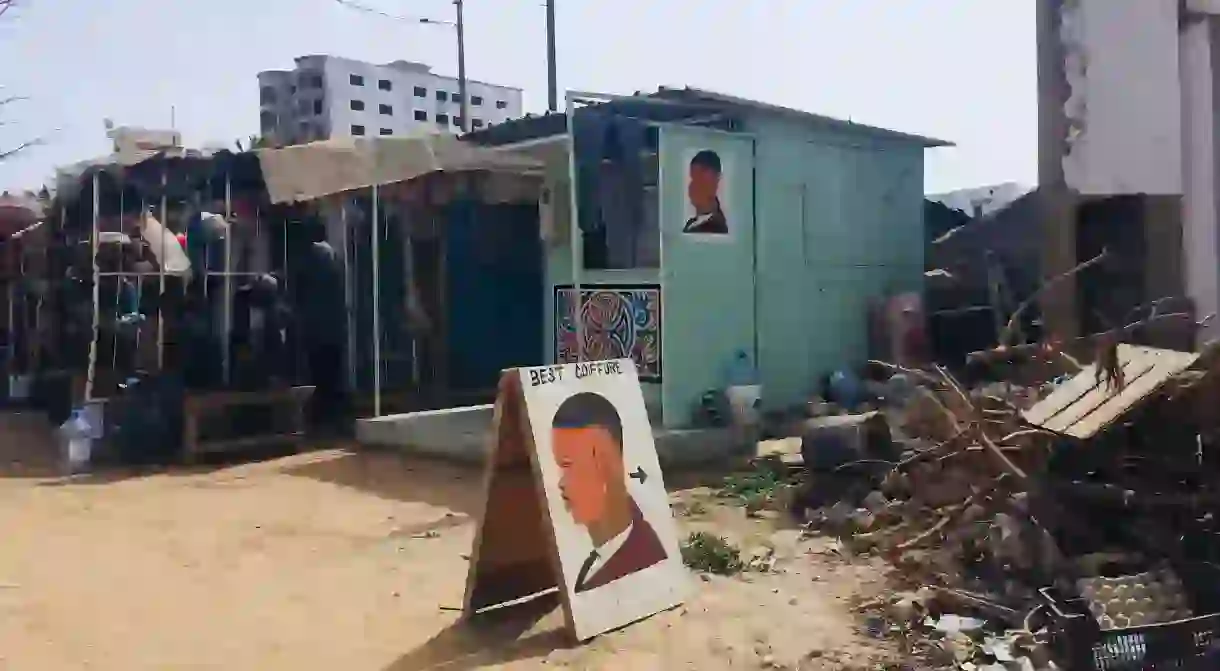The Mystery of Dakar’s Barbershop Signs

Dakar’s streets are dotted with unusual, hand-painted barbershop signs. Instantly recognisable, their distinct styles provide a clue to their mysterious origins.
Like most bustling capitals, Dakar has its fair share of iconic features: the yellow and blue Car Rapides ferrying locals up and down the peninsula; the battered orange and black taxis cannily using pavements and football pitches as shortcuts; corner stores (known as boutiques) doubling up as morning sandwich shops. Each plays a clear role in the day-to-day lives of Dakar’s 3.5 million residents, but one of the region’s idiosyncrasies is shrouded in mystery: the distinctive hand-painted barbershop signs.
The barber’s pole is one of the most recognisable trade signs in the world. With a history dating back to the Middle Ages – when different poles were needed to distinguish between barbers and surgeons – the red and white helix (red, white and blue in the US) is a mainstay on high streets across the world, helping to attract customers and provide publicity on crowded streets. In Dakar, barbers’ signs could not be more different.

Dakar’s barbers are found in every neighbourhood in every district. Some are no more than curtained kiosks or a seat and mirror on the street, others are brick-and-mortar shops with glass windows and electricity. They all invariably feature at least one hand-painted sign announcing their status as a Salon de Coiffure, whilst also depicting a variation on a theme: a side profile of man boasting a sharp haircut and dressed in an even sharper suit-tie combination. The striking similarities suggest a sole origin.
***
Abdou stands in a floor-length maroon boubou outside Chez Barry, a barbershop in the Ouakam district, heavily laden with the distinctive profiles; profiles that he has painted. “I draw what [the barbers] want,” says the convivial Abdou with a proud grin. “Some want facial hair, glasses or a particular hairstyle. Shaved heads with stars and a Nike [tick] are very popular.”

Abdou lives in the town of Keur Massar, 15 miles and a 90-minute bus ride from central Dakar, and has been painting these signs since 1971. He creates his signs in his workshop, but frequently comes into the city to undertake commissions, with each head taking around an hour to paint and costing 1000 CFA (£1.40). He paints the faces orange as “it’s easier to see the face and add features like a chin and a nose”, but chooses the exact colour depending on the background. “For signs, I find a board, paint it white and use a darker orange. For walls or windows, I look at the background colour first” pointing to the lighter shade used on the darkened window of Chez Barry.
His work is visible across the Cap-Vert Peninsula, but, as it turns out, he’s not the only one. “There’s another guy, Jul,” Abdou says in his usual mild-mannered tone but without the grin. “I have never met him, but he sees my signs and goes and leaves his [phone] number by them.” Explaining that all his commissions are by word of mouth and that he doesn’t need to advertise, Abdou says that he’s annoyed that “people think we are the same artist. I can do any face – even famous people,” he says.

Walking around the dusty backstreets of Ngor in the north of Dakar, the differences between their work are subtly apparent in their choice of mouth, nose and eyes, but markedly different in their choice of shade, with Jul favouring yellow to Abdou’s orange. In Virage, Jul has written his number on the inside door of a barbers’ kiosk, whose owner admits to knowing both painters and having no loyalty toward either of them. He paid 4000 CFA (£5.50) for the Jul profile on his window.
Jul is sketching a commission at Chez Mamadou in Ouakam, a 10-minute walk from Chez Barry. His broad, toothy smile and paint-splattered jeans are accompanied by an energetic bop as he speaks about his work, often getting distracted by his handheld radio blaring out African jazz-ska. “I have been painting for 20 years. When I started, there was nothing. Everyone had afros and there were not many hairdressers.” He claims to be “constantly called for commissions all over Dakar” as he “is well-known by all the barbers,” before turning up the sound on his portable radio and imitating James Brown.
However, his jovial nature changes when the subject moves on to Abdou. “That old man is an imposter. I am the original,” he says, before adding that he’d been doing these paintings for at least 25 to 30 years. When discussing the differences between the two, he laughs at Abdou’s style: “He does too big noses and ties at a slant. Ties are not like that. They come down vertically from the collar.”
As personas come, Jul and Adbou are polar opposites – the bouncy hubris of a wheeler-dealer versus the mild-mannered charm of a librarian – but both take enormous pride in their work and their personal contribution to Dakar’s culture. Car Rapides, taxis and boutiques may also compete for business, but the secret rivalry behind the city’s barbershop signs leaves a mark like no other.














